MY YORKVILLE VILLAGE MEMORIES
In the mid 1960s a tiny area in Toronto, formerly a village incorporated into the city in 1876, became the centre of hipness in Canada.
Bordered by Avenue Road, Bloor Street, Yonge Street and Scollard Street, for just a few years, it attracted young people from downtown, from the suburbs, and even small towns across the country. Driven by music, sex, drugs and social change, it produced Canada’s music scene and influenced Toronto’s nightlife for decades. Although it burned brightly for only a few years, Yorkville was included in the list of legendary 1960s hippie gatherings across North America and became the source of MY YORKVILLE VILLAGE MEMORIES.
Yorkville was a collection of 19th century Victorian buildings that provided residential housing for the first half of the 20th century.
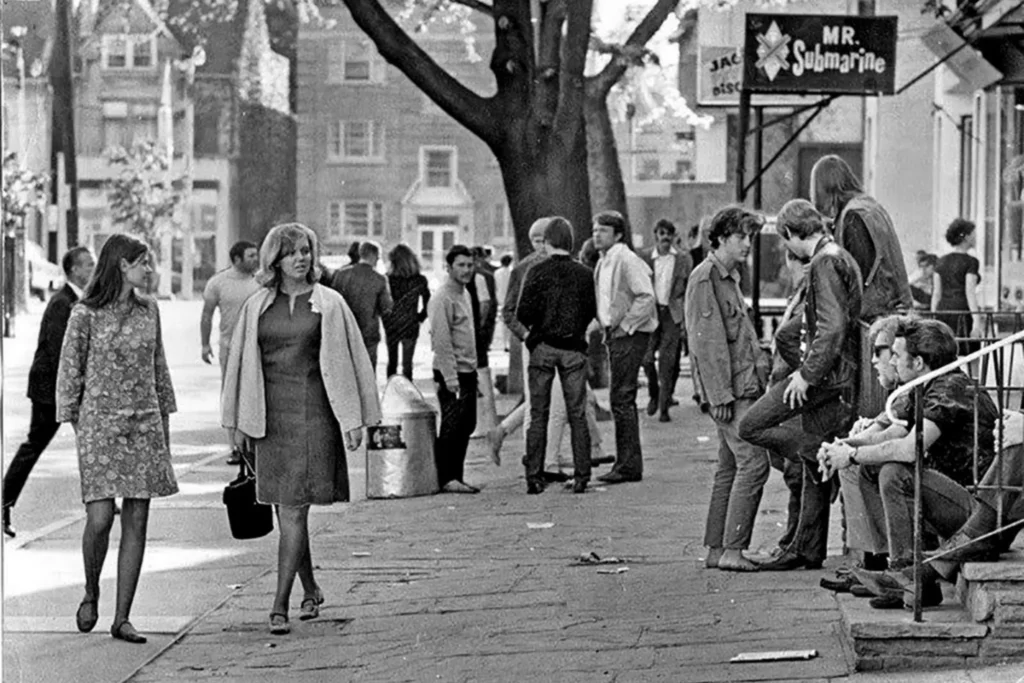
In 1950, when Canada began to allow immigration from post-war central Europe, many Europeans came and settled in Toronto in downtown areas, setting up businesses that could provide reminders of home. Quite a few wonderful Hungarian restaurants started this way. In Toronto the Good, where liquor licenses were hard to obtain, the idea of coffee houses took off. These were small remembrances of the famous political hotbeds in Europe; check the history of the French Revolution. Imported and rare coffees, wonderful crepes, amazing strudels and other European-influenced foods were brought to feed those who might linger.
Yorkville, in the late 50s and early 60s was an eclectic mix of boutiques, art galleries, restaurants and coffee houses. Some spaces accommodated a mix of these, while their proprietors held forth on their philosophical, political or spiritual views. This was unique at a time when the general population was bent on conformity, and those young people who wanted to explore being different began to drop in for coffee. Beatniks, they were called. Jack Kerouac was a venerated author. The Ontario drinking age was 21. Coffee was the beverage of choice; “tea” was how marijuana was known.
Some of the coffee houses beginning in the early 1960s invited folk musicians and poets to entertain customers.
There wasn’t much money involved; the proprietors weren’t getting rich, and the poets and musicians were young and unknown. Names like Murray McLaughlin, Neil Young, Joni Mitchell, David DePoe, and Milton Acorn did not draw big crowds in those days, and they were flexible about the times they played or read poetry because most of them lived in the area. (Mitchell, whose maiden name was Anderson and was married to folksinger Chuck Mitchell lived upstairs from a coffee house on Yorkville Avenue for a time. It is said she wrote “Night in the City” (1967) about that.) Yonge Street was much more conservative at that time; nightclubs offered jazz and dancebands for middle-class middle-aged hipsters who could spend on alcoholic beverages.
![Image of "city fathers" [members of city council] entering the Penny Farthing on their tour of Yorkville.
Source: Toronto Telegram](https://joesplace.online/wp-content/uploads/2023/04/Image-of-city-fathers-members-of-city-council-entering-the-Penny-Farthing-on-their-tour-of-Yorkville-1-300x198.jpg)
It was Toronto’s daily newspapers that played up the unusual atmosphere in Yorkville. By 1963 and 64, youths with Beatle haircuts and girls with miniskirts were attracting photographers. There were articles describing the ease and the dangers of obtaining sex in the area, suggesting that young people under the influence of illicit drugs were tossing away their morals.
All the fearmongering in the newspapers, however, simply made it seem like more fun. In the summer of 1965, my 15-year-old cousin begged my dad to pile us all into the family stationwagon to see what it was all about. We drove to Yorkville and Cumberland, and although we did our share of giggling, we imagined ourselves walking the streets with the hip, drinking coffee, and meeting potential mates (of both sexes).
By the summer of 1966, rock had influenced the world, and had invaded Yorkville.
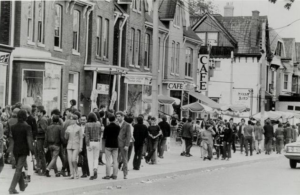
The rhythm and blues scene on Yonge St began to expand to Yorkville. David Clayton-Thomas and his band the Shays, and then the Bossmen, enjoyed listening to acts like John Lee Hooker, and Sonny Terry and Brownie McGee and enjoyed the vibe. When their own single, “Brainwashed”, hit the Top 40 they became fixtures in Yorkville at a club called The Mynah Bird.
The club’s house band, for a time was called The Mynah Birds, and initially was led by local R&B legend Bobbi Lee Justice. In 1967 a new lineup was introduced which included Rick James, Bruce Palmer and Neil Young. I remember there really was a mynah bird, owned by the club owner, Colin Kerr, which talked. Kerr apparently hoped to get the bird on Ed Sullivan, but never succeeded. A fuss was made about the introduction of the topless waitress concept in Canada, but the girls actually wore pasties and there was so much smoke from cigarettes and the use of dry ice that no obscenity charges could be laid. The prurient interest was not served, and Kerr gradually let the girls cover up a little more.
The Ugly Ducklings released their 1967 single, “Gaslight” the following year, and I cannot listen to it now without seeing crowds of youths walking the streets in 1967 in Yorkville. They often played a club known as the Penny Farthing. John McHugh and his wife owned that, and actually installed a pool and patio for their patrons.
Waitresses wore bikini tops. Bernie Finkelstein and some other music agents sponsored a ‘meet and greet’ at the Penny Farthing in the spring of ’68 for high school student council members. I attended and gathered out on the patio with many others and listened to live music (nothing memorable I assure you). I sipped a very large glass of gingerale which I naively left unattended while mingling. At about 10:30 pm I started to feel dizzy and called a cab. When I got home I went straight to bed; the bed was spinning and then I passed out. I was much more careful about my surroundings in future, but have since heard many similar experiences from women who hung out in the Village.
And then there was the Riverboat.
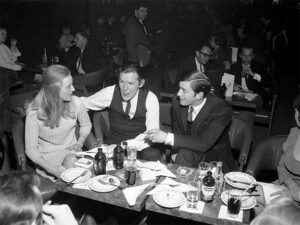
It was a club located in the lower level of a Victorian house, which held about 120 on red leather benches (aka banquettes). It is difficult to reel off the performers who played there because there were so many, and they were so varied. Folk music held sway for a time (Joni Mitchell, Murry McLaughlin, Dan Hill, Buffy Ste Marie, Leonard Cohen), but rhythm and blues was popular too (Sonny Terry/Brownie McGee, Bill Withers, John Lee Hooker). It was a happening place to go just to hang; I vividly remember a trip to the Riverboat after seeing Easy Rider at the cinema in 1969. The glorification of hippie culture in the movie made me feel like I fit right into what we used to call The Village.
The Riverboat was often lined up, largely because of the quality of the entertainment. I can attest to the added attraction, however, of the wonderful coffee and the amazing apple strudel which could be ordered while watching the show. Remember, liquor licenses were unheard of in Yorkville at that time, so great food at low prices, good coffee, and good music were the only ways to pack in the under-21 crowds.
From 1965 to 1969, young people in Toronto coalesced into groups.
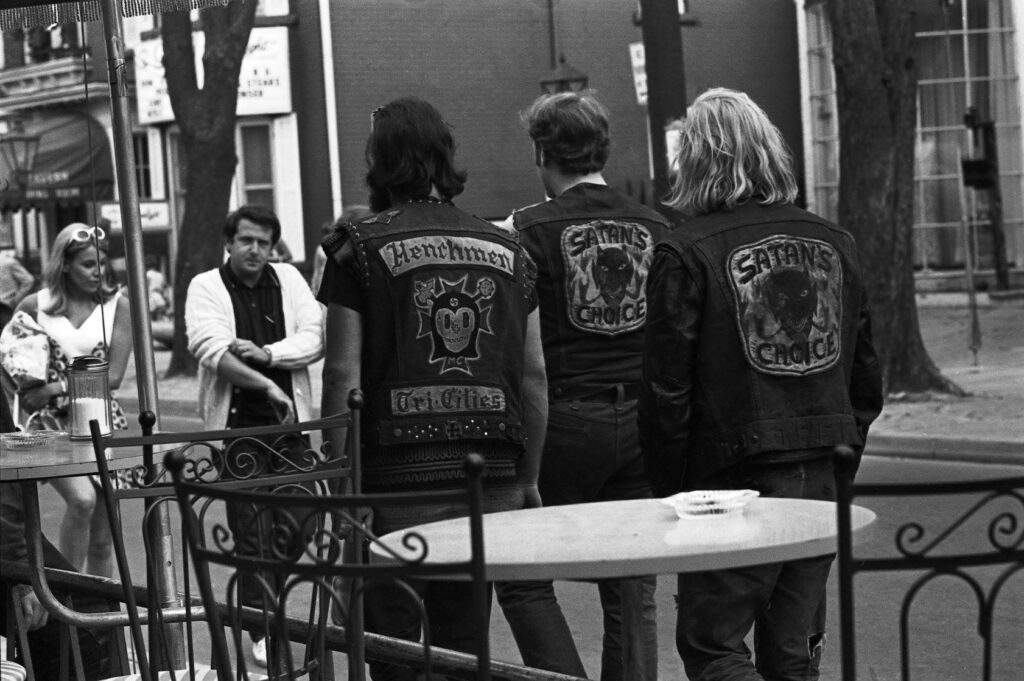
The popularity of motorcycle clubs rose significantly, and biker gangs were increasingly seen on the streets of Yorkville. I remember the Vagabonds as being the premier organization, but Hells Angels and the Outlaws were other clubs that were visible.
Another notorious group of young men were draft dodgers and deserters from the American forces, evading the Vietnam war. It has remained difficult to establish exactly how many Americans migrated to Canada to escape the draft, and of those how many congregated in Toronto, but between 30,000 and 60,000 have been estimated. Bill King and Eric Nagler, respected Canadian musicians, have been interviewed about their experiences coming to Canada and remaining here. The Canadian government paid little attention to young Americans arriving; passports weren’t even required in those days to cross the borders.
Americans avoiding the draft were part of the pageant in Yorkville.
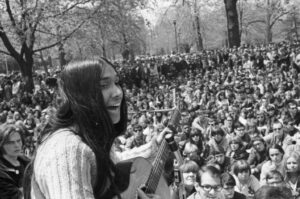
Young men arriving in Toronto quickly found that their identities weren’t liabilities; for some reason Canadian youth were fascinated and welcomed them. There was a kind of cachet around dating or befriending a draft dodger. Deserters were considered a little more notorious; those who had actually seen any combat were quiet about it, because they were facing harsher punishment south of the border.
Both the biker gangs and Americans evading the draft were more likely sources for illicit drugs. In 1965 the popular street drugs in Yorkville were LSD, acid, commercial pills like Quaaludes, hashish and marijuana in various forms. Hardcore addictive drugs like heroin, cocaine and morphine were much less common, harder to find, and much more expensive. Many young people came to Yorkville to be introduced to psychedelics and grass; remember, many drugs like crack, Ecstasy, crystal meth, fentanyl, and opioids were unknown or did not exist.
With the growing drug use came problems that are familiar today.
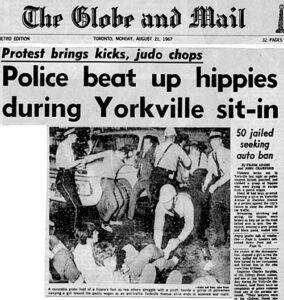
The press, who were initially admiring of the bohemian atmosphere, began to highlight the outbreaks of hepatitis and the unrest among young people. Traffic in Yorkville became almost intolerable (between cruisers and suburban families and bikers) and a sit-down strike occurred in the summer of 1967 to call for a ban on traffic.
The police broke up the strike and made 50 arrests, injuring some participants. The chief of police justified the action, saying law and order on the streets was threatened. Vaccine stations were set up in the summer of 1967 to try to prevent the spread of hepatitis, and the presence of police patrols in the Village increased significantly, which drove away those who did not want to encounter the law.
The music kept going, thankfully, but the counter culture was finding other places to gather. Yonge St., Rochdale, and elsewhere near U of T and Ryerson (now called MTU) campuses began to attract small gatherings. During the summers of 1968 and 1969 Yorkville remained lively but change, as everywhere else on the continent, was in the air.
By the summer of 1970, the negative newspaper articles and MPP Syl App’s comment about Yorkville being “a festering sore in the centre of Toronto” cooled things down.
Many of the Canadian performers who sought stardom moved to the U.S.
The popular coffee houses closed down or became something else. In 1971 the drinking age in Ontario was lowered to 18, along with loosening of other restrictive liquor laws. The Ontario PC party of William Davis, who also lowered the voting age, was looking to the fall election. Young people interested in the Toronto music scene could now legally drink in bars all over the city. New audiences expected live music at every venue, and at 10 cents a glass for draft beer they could hear over 2500 bands and acts in Toronto alone, not to mention imports. A cup of coffee and a pastry just couldn’t compete, and the hip drifted from Yorkville.
The area turned into a high-end retail heaven overnight and Yorkville became known as The Mink Mile, retaining the great coffee and restaurants for Toronto’s elite. It became the place to get a coiffure, buy antique china, acquire high-end fashion and up-and-coming art. Property values skyrocketed; rundown Victorian houses were renovated to the nines in avant-garde style (check out York Square). The emphasis on music drifted out of Yorkville, but remained on many city streets during the 1970s.
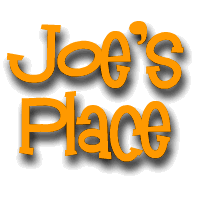
I saw two different live shows in Yorkville (Tim Hardin and Johnny Hartford)…my problem is I cannot remember the name of the coffeehouse. Is there an available list of names?
Many of the coffee houses in Yorkville supported local talent, and could not afford to pay musicians much to play. Tim Hardin and John Hartford were both well-known American folk/bluegrass legends and I have to think they were playing at the Riverboat when you saw them. Check out details on the Riverboat coffee house on the Internet.
awesome
great article Cindy….brings back a lot of memories for me…..
Very difficult to focus on Yorkville Village without including other scenes, such as Rochdale, but for brevity I did so. The banner photo, showing a young Buffy Ste Marie, is actually of a protest rally held in Queen’s Park in the late 60s. Queen’s Park is a green space surrounded by the provincial parliament buildings and University of Toronto. It is within a couple of blocks of Yorkville, and no doubt gathered an audience from the Village. Ste Marie is still performing and protesting and is famous for writing several well-known folk songs, including Universal Soldier.
Hi Cindy.. Your memory is wrong !! I am Bobbi Lee Justice lead singer for Bobbi Lee and The Scepters and we were the house band at The Mynah Bird from 64 to 66 and also the original ” Mynah Birds ” and first to record The Mynah Bird song for Colin Kerr and Rajah the Mynah Bird … Neil Young and Rick James version of The Mynah Birds and came after us… They never played or were house band at Mynah Bird from 64 to 67 .. We were !! This is well documented on the web if you had done your research so please make the correction and give credit to who were the actual house band at Mynah Bird .. Thank You. BLJ
Bobbie Lee, please accept my apologies if my comments on The Mynah Bird offended you, and convey them also to Dan Roach. I did indeed do research on the Mynah Bird and did not come across your name, using several Internet sites, especially Wikipedia, and also scholarly books from Brock U. library. The “history” of Yorkville is still based on the recollections of those who were there (that will change in a few years when we are all gone). This is far from reliable, and in fact is sometimes prone to bias on the part of who is telling the story. However, these personal stories should be retained, even if they clash with others, to preserve the colour of the times. Give me some time to make changes, and I will note your involvement in my article.